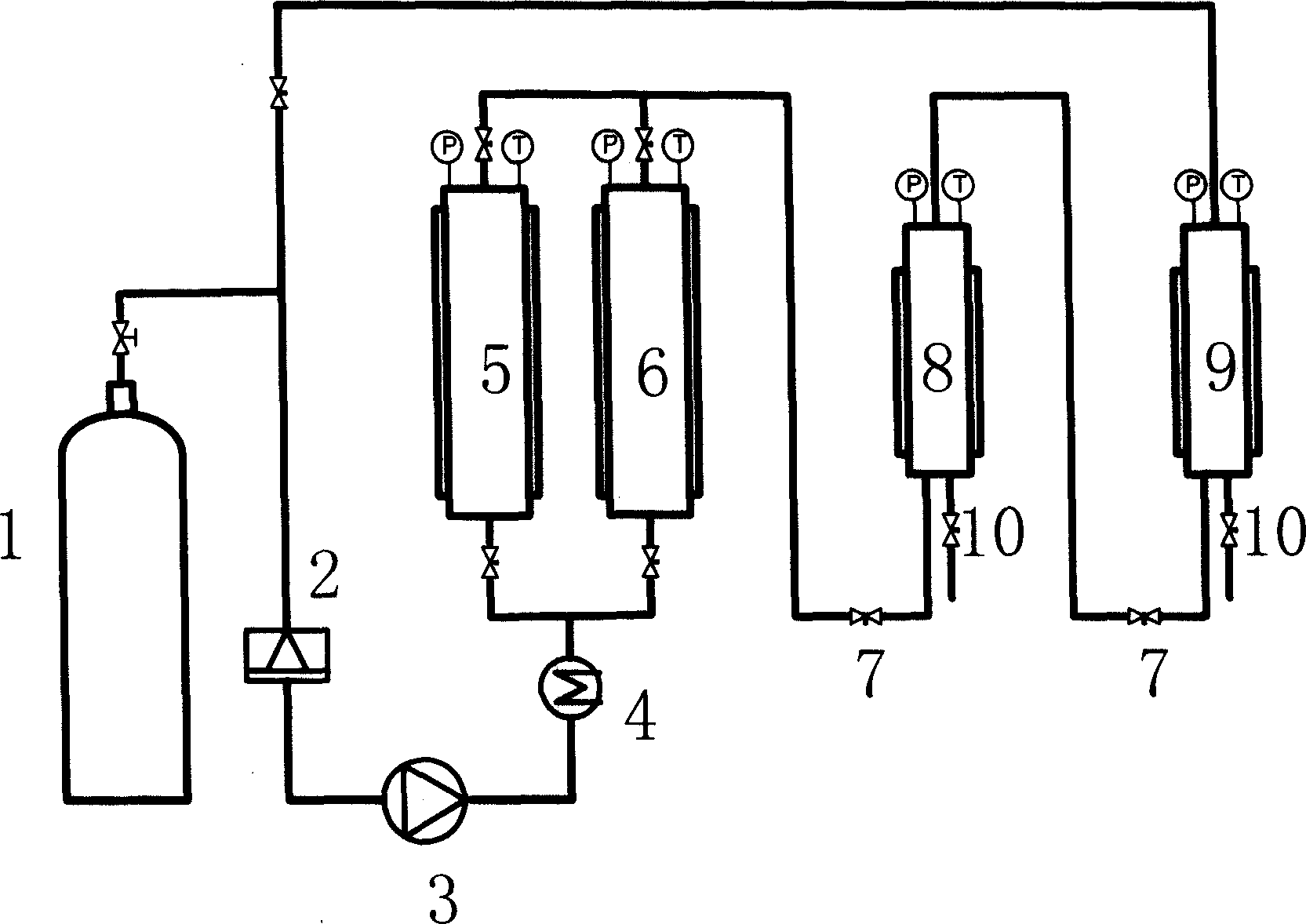Method of extracting safflower oil using super-critical carbon dioxide
A carbon dioxide, safflower seed oil technology, applied in the direction of fat oil/fat production, fat production, etc., to achieve the effect of fast extraction and high purity
- Summary
- Abstract
- Description
- Claims
- Application Information
AI Technical Summary
Problems solved by technology
Method used
Image
Examples
Embodiment 1
[0022] Embodiment 1: Take 50 grams of safflower seeds, grind them to an average particle size of 0.4 mm, put them in an extraction tank after drying and seal them. Open the gas tank, carbon dioxide reaches the extraction tank through the condensation tank and high-pressure pump, and extracts at 28MPa, 50°C, and a flow rate of 4.5L / h; the extract enters the primary separation tank, and performs primary separation at 10MPa, 45°C to obtain yellow Transparent safflower oil; carbon dioxide continues to enter the secondary separation tank, and a little water and safflower oil are separated in the secondary separation tank at 6MPa and 40°C. The carbon dioxide separated from the separation tank returns to the condensation tank. After 2 hours of dynamic operation, 12.22 grams of safflower seed oil was obtained from the separation tank, with an extraction rate of 24.4%, accounting for 90.5% of the oil content. The content of linoleic acid in the obtained oil was 85.6%.
Embodiment 2
[0023] Embodiment 2: Take 50 grams of safflower seeds, grind them to an average particle size of 0.4 mm, put them in an extraction tank after drying and seal them. Open the gas tank, carbon dioxide reaches the extraction tank through the condensation tank and high-pressure pump, and extracts at 24MPa, 45°C, and a flow rate of 4.5L / h; the extract enters the primary separation tank, and performs primary separation at 10MPa, 50°C to obtain yellow Transparent safflower seed oil; carbon dioxide continues to enter the secondary separation tank, and a little water and safflower seed oil are separated in the secondary separation tank at 5MPa and 30°C. The carbon dioxide separated from the separation tank returns to the condensation tank. After 2 hours of dynamic operation, 11.9 grams of safflower seed oil was obtained from the separation tank, with an extraction rate of 23.8%, accounting for 88.2% of the oil content. The content of linoleic acid in the obtained oil was 84.9%.
Embodiment 3
[0024] Embodiment 3: Take 50 grams of safflower seeds, grind them to an average particle size of 0.5 mm, put them in an extraction tank after drying and seal them. Open the gas tank, carbon dioxide reaches the extraction tank through the condensation tank and high-pressure pump, and extracts at 20MPa, 35°C, and a flow rate of 4.5L / h; the extract enters the primary separation tank, and performs primary separation at 12MPa, 35°C to obtain yellow Transparent safflower oil; carbon dioxide continues to enter the secondary separation tank, and a little water and safflower oil are separated in the secondary separation tank at 6MPa and 35°C. The carbon dioxide separated from the separation tank returns to the condensation tank. After 2 hours of dynamic operation, 7.1 grams of safflower seed oil was obtained from the separation tank, with an extraction rate of 14.2%, accounting for 52.6% of the oil content. The content of linoleic acid in the obtained oil was 84.8%.
PUM
| Property | Measurement | Unit |
|---|---|---|
| particle size | aaaaa | aaaaa |
Abstract
Description
Claims
Application Information
 Login to View More
Login to View More - R&D
- Intellectual Property
- Life Sciences
- Materials
- Tech Scout
- Unparalleled Data Quality
- Higher Quality Content
- 60% Fewer Hallucinations
Browse by: Latest US Patents, China's latest patents, Technical Efficacy Thesaurus, Application Domain, Technology Topic, Popular Technical Reports.
© 2025 PatSnap. All rights reserved.Legal|Privacy policy|Modern Slavery Act Transparency Statement|Sitemap|About US| Contact US: help@patsnap.com

